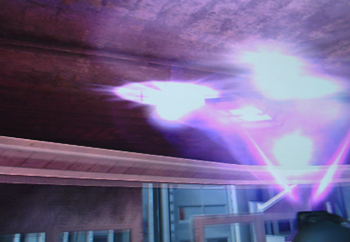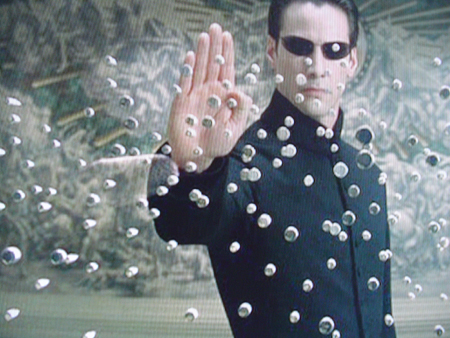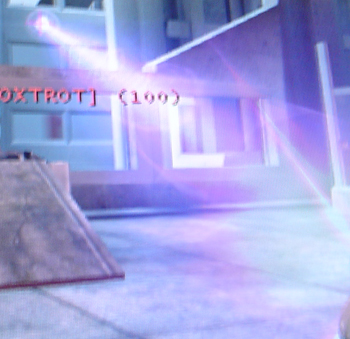A Guide to Choosing the Right 19" LCD Monitor - 7 Models Reviewed
by Kristopher Kubicki on November 30, 2004 12:04 AM EST- Posted in
- Displays
Application Analysis
The core of our LCD benchmarking comes from real application analysis. We play with a lot of monitors and it gets easier for us each time to pick out problems with an LCD just by using the right application. Here are a few quick looks at some demanding full screen applications. We already ran ColorVision's OptiCal software, so all of our monitors are calibrated and adjusted to the same curves.High Definition Video - We cheated a little bit on this portion of the analysis and handicapped all the monitors. None of these LCDs can display a true HD signal correctly without compressing pixels or cropping the image. Nevertheless, we set out to play a WMV9 1080i signal on our monitors with the interest in looking for color differences. Since our monitors have all been precalibrated, we expect the same image on each screen. Unfortunately, no amount of calibration can fix some things; we still noticed "off" reds on most of the monitors (including the Samsung 193P, the Sony, the Planar and the Dell). The BenQ, NuTech and ViewSonic occasionally managed to wash out blues a little too easily, and when looking in the right places, we could easily spot some of the differences between the 6-bit BenQ image.
The Matrix Reload, The Matrix - We use the Matrix series to test full motion video on our LCDs. Since the Matrix isn't the best movie to test color reproduction, we typically only look for motion blur or other imperfections. As expected, we noticed no fatal flaws in any of the LCDs. Although, while running some of them side by side, it became readily apparent that some monitors put a slight hint of color on the application - noticeably, the NuTech and ViewSonic monitors had a slight bluish tint.
WarHammer 40K, Dawn of War - When looking for a monitor's response time, we generally only consult first-person shooters for reference. However, those of you who have played a fast-paced game of Warcraft III or NeverWinter Nights will know that scrolling around for hours puts a severe tax on the monitor. Although we didn't notice any profound difference on the 16ms BenQ monitor, we could tell that the Sony and Planar had occasional difficulty in poorly lit areas of the game. For example, when scrolling around the last level of DOW where the majority of the level is gray ash and black soot, we would see the edge of the menu bar and status icons bleed into the ground.
Looking closer, we noticed some small differences with heavy weapons fire while scrolling on the BenQ FP931 and Samsung 193P. With enough patience, we can actually count the tracers shot over long distances, but when viewing the same scene on the Planar PE191M, the same task seems almost impossible. Attempting to do the same on the ViewSonic LCD proves futile sometimes, but not others.
Max Payne 2 - The extreme light and dark transitions in Max Payne still provide us with the sufficient criteria to benchmark transient response time; specifically, we can focus on the light and dark extremes. However, in all of the demos that we ran, we noticed virtually no difference from one monitor to another. The Samsung 193P looked a little more vibrant than its competitors, but the NuTech and ViewSonic models were displaying particularly brighter lights while maintaining the same dark hues as the SyncMaster 193P. Revisiting Max Payne with the Dell 2001FP was a little bit of a surprise. Even with the brightness set to its maximum, we were a little surprised at how much brighter the 19" LCDs were running.
Halo, Unreal Tournament 2004 - Halo and UT2K4 have very similar results, but now, we are looking for fast motion and color correctness at the same time. Again, we noticed a slightly blue tint to the BenQ monitor even after it was corrected with OptiCal. All of the monitors had a tendency to wash out, particularly in bright areas, and part of that is because we are running all of our monitors at the highest brightness levels. Specifically, the BenQ and Samsung 910V would wash out especially in bright explosions (a well-placed Redeemer usually did the trick). On occasion, the Sony SDM-934 and the Planar PE191M would blur in heavy laser battles (4 or 5 shock rifle shots firing across the screen would usually leave a small trail).

ViewSonic Q190MB
Click to Enlarge.














97 Comments
View All Comments
MAME - Tuesday, November 30, 2004 - link
thank god the dell 2001fp is the (2nd) best one here. I got it for $650 a few days ago on a whim. The reviews are kinda mixed but there's a 21 day return policy. Problem is, it's 21 days from the invoice and the expected shipping date would put the LCD in my hands AFTER that time. Thus, I couldn't return it even .1 seconds after receiving it :-/Alas, it seems the monitor is a good choice nonetheless and I should have decent product on my hands soon. My eyes can't wait!
Peter - Tuesday, November 30, 2004 - link
Because that's a barenaked LCD Panel, not a finished product?Azsen - Tuesday, November 30, 2004 - link
Hi, why does no-one have any information on this monitor:http://www.samsung.com/Products/TFTLCD/Monitors_n_...
19" 8ms response, 600:1 ratio
Peter - Tuesday, November 30, 2004 - link
Regarding the aspect ratio: If someone had taken the time to actually MEASURE, they would have found that all those LCD panels that sport a 1280x1024 resolution actually do measure 5:4, thus having correct aspect ratio at that resolution. Moot point, actually.(Running a CRT at 1280x1024 is wrongwrongwrong, though.)
Peter
ceefka - Tuesday, November 30, 2004 - link
#4 Jeff7181: LCD's use less power, take up less space (especially from 19" on) and produce less interference and heat. That times 2 if you are working with 2 screens. If a CRT works for you, then fine. It's not so much ignorance as it is choice.KristopherKubicki - Tuesday, November 30, 2004 - link
D0rkIRL: Thanks for the catch. Fixed.bookem dano: We know of the problem and we should have it fixed soon.
klah: I was only aware of Xbitlabs doing so. We feel that the methods for measuring reponse time thus far are OK, but not represent gray to gray response time measurements well. Its something we are working on and we will probably have a better methodology before the next roundup.
Kristopher
bookem dano - Tuesday, November 30, 2004 - link
For some reason while looking at this article, my cpu was pegged at 100%.I tried IE, Net, FIre, all same thing. Quite annoying.
carlivar - Tuesday, November 30, 2004 - link
OK so the tips at the beginning say to get a monitor with the correct aspect ratio such as 1280x960 resolution. I agree. Then all of the monitors reviewed (other than the Dell) have 1280x1024, which they specifically warn against.I know that most 19" LCDs are 1280x1024 but couldn't they at least have explained why this is?
And actually, why is this?! I don't understand the popularity of 1280x1024 instead of 1280x960! IT DOES NOT MAKE ANY SENSE.
Googer - Tuesday, November 30, 2004 - link
You will have to pry MY CRT from my cold dead hands before I let an LCD connect to my Graphics Card.klah - Tuesday, November 30, 2004 - link
"The TrTf response time is normally a pretty useless measurement - but it makes for an easy specification in which to market LCDs. "Why not provide us with a graphs of response times across the entire spectrum? There are at least 2 sites that do so now: X-bit and Tom's.